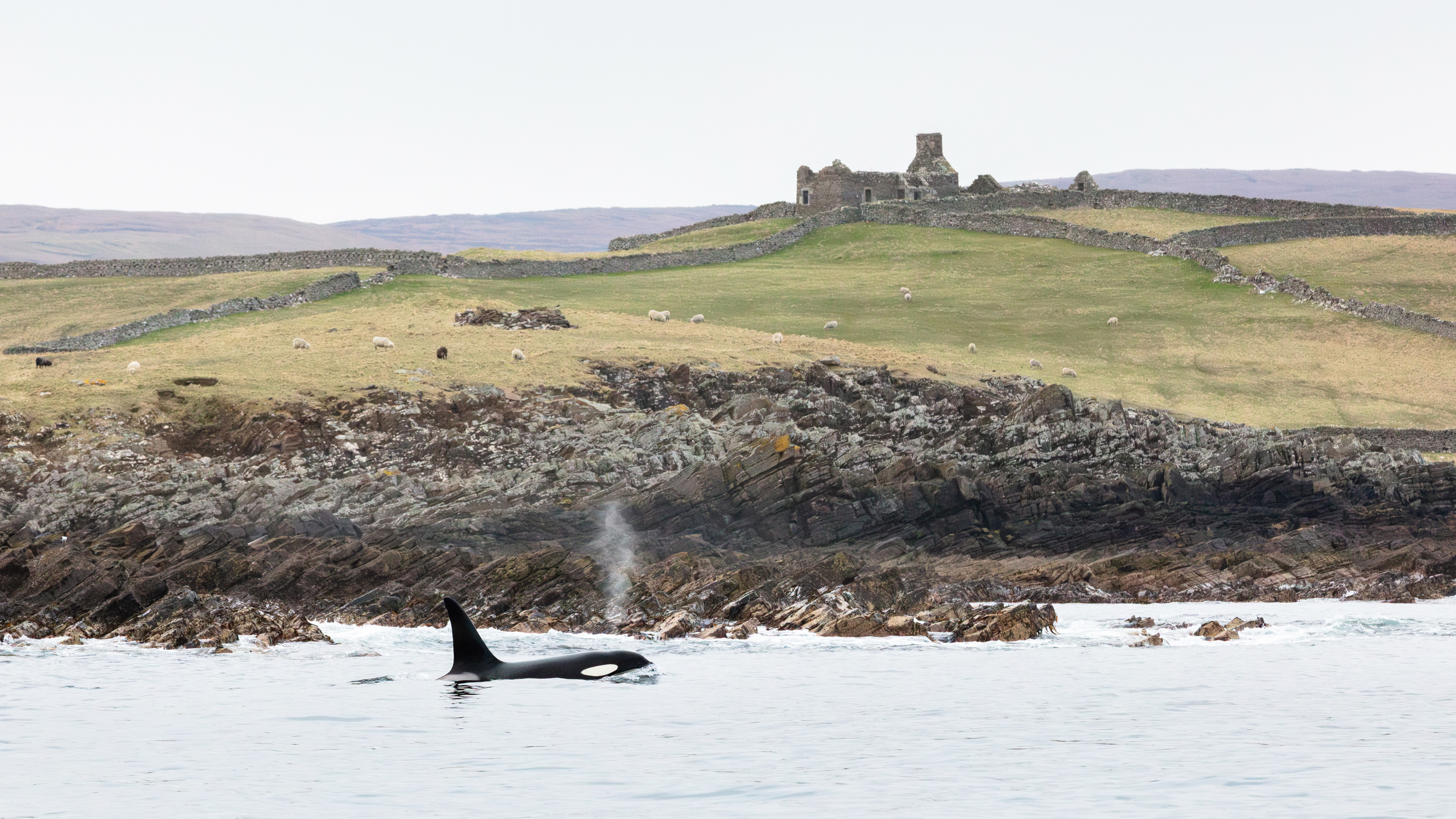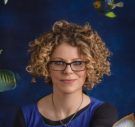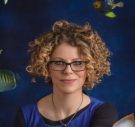Killer whales: The perilously rare and super-smart predator we risk loosing from British waters forever
They’ve recently made headlines for interfering with boats, but intelligent, family-focused and remarkably long-lived orcas–better known as killer whales–contain multitudes.


A few years ago, I travelled to the northernmost reaches of Scotland and visited the Shetland Islands, where I hoped I might encounter a giant sea creature. Its dorsal fin alone, sticking up above the waves, would be taller than me. I longed to catch a glimpse of slick black and white skin and feel the thrill of being in the presence of a formidable, super-smart predator. Shetland gave me my best chance anywhere in the British Isles of seeing a wild orca. Around this isolated subarctic archipelago the sea is brain-achingly cold and rich in wildlife, including large populations of harbour seals and grey seals. That’s why the orcas come — to hunt these nourishingly blubbery marine mammals.
Two or three semi-residential orca pods regularly appear around Shetland. Collectively known as the Northern Isles Community, they sometimes roam south to the Orkney Islands and on towards the Scottish mainland, as well as to the Faroe Islands and Iceland. In Shetland, they’re frequently joined by several Icelandic pods that also come to hunt for seals. At any time there can be dozens of orcas prowling around the small cluster of islands that make up Shetland — and when they come within sight of land, there are always devoted orca fans following them, posting sightings on social media, rushing from bay to bay, beach to cliff top, scanning the sea and sharing photos of dorsal fins reaching above the waves. If you happen to be in the right part of Shetland at the right time, you could get lucky and see an orca swimming by.
A post shared by Andrew Simpson (@shetland_by_drone)
A photo posted by on
Orcas, or killer whales, are the world’s largest dolphins. They grow to between 25ft and 30ft long and can weigh more than five tons, roughly the full body length (trunk included) and heft of an African bush elephant. Globally, orcas live more widely than any other mammals, from the icy waters of the Arctic and Antarctica, to tropical and temperate seas. They live in tight-knit pods often led by a female elder, the children and grandchildren often staying with her all through her long life and learning from her how to hunt.
Renowned for their intelligence, orcas work together to target different prey types; in Antarctica, they swish their tails together to wash seals off floating ice floes; in Patagonia, they deliberately beach themselves to hunt sea lions; off South Africa, orcas work together to hunt another of the ocean’s top predators, great white sharks. In southern Europe, in the sea off Gibraltar, an orca pod recently gained notoriety for interfering with sailboats, tearing off rudders and causing many vessels to sink. The boat-meddling orcas have never harmed any people on board and scientists are still puzzling over why they started doing this.

Orcas differ in size and have varying prey preferences and hunting techniques, and even dialects, depending on where in the world they are native to.
A whale of a tale
• Orcas are one of only five animals in which females are known to go through menopause and outlive their fertility. The other species are short-finned pilot whales, belugas, narwhals and humans
• Post-menopausal female orcas play vital roles in their pods; they hold knowledge of the best places to hunt and guard their sons from getting into fights with other orcas
• This year, scientists observed that orcas in the Salish Sea, off the coasts of the US state of Washington and Canada’s British Columbia, groom each other with strands of kelp. The orcas bite off short chunks of the slippery seaweed, then roll it between their bodies, perhaps to slough off dead skin or remove parasites. It’s the first time marine mammals have been seen performing this type of mutual grooming
• Orcas are poorly adapted for living in frozen seas because their tall dorsal fins make it difficult for them to rise to the surface under the ice and reach air holes to breathe. As the climate crisis is causing sea ice to melt in the Arctic, orcas are now moving further north and making life more dangerous for their prey, including bowhead whales and narwhals
• There have been several reported sightings of orcas off the coast of Northumberland, near the Farne Islands, and the Isles of Scilly, this year
• Orcas are important in human cultures around the world. More than 2,000 years ago, people from the Paracas culture in the desert of southern Peru created stone artworks depicting giant monsters, perhaps mythical orcas that were sacred messengers to the gods. Today, orcas continue to feature in many stories, artworks and religious ceremonies of Indigenous peoples of the Pacific Northwest coasts of Canada and North America. Orcas appear as shapeshifters that cross boundaries between life and death, ocean and land
As well as Shetland, orcas also roam around the islands of the Hebrides, but those ones are much harder to spot. The West Coast Community is the last remaining resident pod of orcas in British waters and they are perilously rare and endangered. In 2016, tragedy struck when a female from this community, called Lulu, washed up dead on a beach on the Isle of Tiree. An autopsy revealed she had drowned after getting her tail tangled in fishing gear, something that shouldn’t normally happen to nimble orcas. Tests revealed her body contained immense concentrations of manmade toxins — more than almost any other animal that’s been tested — which probably hampered her brain function and immune system and may have made her more vulnerable to entanglement. The poisons are also the likely culprit for Lulu’s infertility. She was at least 20 years old and sexually mature when she died, yet she had never given birth to a calf. She left behind a dwindling group of orcas. Eight individuals have been identified in the West Coast Community, but, recently, only two have been spotted, both of them males.
Chemical pollution is a major threat to orcas all around the world. Toxic industrial chemicals leach into the ocean and don’t readily break down, but build up in food webs, getting passed on from prey to predators. Orcas can live for a century and through their long lives as apex predators they take on a huge toxic load that accumulates in their fatty blubber. One study predicted that polychlorinated biphenyls, or PCBs, lingering in the ocean could lead to the collapse of half the world’s orca populations by the end of this century.
Although the production of some dangerous chemicals such as PCBs has been widely banned, others have taken their place and pose ever greater risks. Thousands of synthetic compounds, dubbed ‘forever chemicals’ because they take so long to break down, are highly toxic to humans and other animals, but efforts to control their production are alarmingly slow. As it becomes increasingly obvious how badly our world is becoming contaminated with forever chemicals, which have been detected in everything from Arctic sea ice to domestic drinking water supplies and the bodies of unborn human babies, the need for strict regulations becomes ever more urgent. Phasing out these dangerous substances is not only vital for human health, but it will help keep the ocean healthy for everything that lives there, from plankton to fish and the imperilled top predators, the orcas.
Exquisite houses, the beauty of Nature, and how to get the most from your life, straight to your inbox.
Knowing about the precarious future of orcas made it all the more frustrating when, during my time in Shetland, I was always in the wrong place to see them. On days when I visited the northerly islands of the archipelago, the orcas appeared in the south; when I headed east they showed up in the west. Then, with one day left, a pod led by a matriarch known as Vaila visited a beautiful beach where waves crash towards each other along a narrow arc of sand connecting to St Ninian’s Isle. In the cove on one side, three adult orcas arrived accompanied by a gaggle of young ones. The elder orcas demonstrated their hunting prowess, chasing and killing several seals, then tenderly passing chunks of food to the juveniles.
As all this was going on, a crowd gathered on the surrounding cliffs and looked down on the hunting scene, but I was not among them. I was at the other end of the archipelago, separated by several inter-island boat rides and with no hope of getting there in time to witness this wild drama unfold. Even so, it was reassuring to know that there are still giant predators doing what they need to do to survive and roaming the British seas.
This feature originally appeared in the July 30 2025, issue of Country Life. Click here for more information on how to subscribe
Dr Helen Scales is a marine biologist, writer and broadcaster. She is author of many books about the ocean including the Guardian bestseller Spirals in Time, New York Times top summer read The Brilliant Abyss and the children’s books What a Shell Can Tell and Scientists in the Wild. She writes for National Geographic Magazine, the Guardian, and New Scientist, among others. She teaches at Cambridge University, is a storytelling ambassador for the Save Our Seas Foundation and science advisor for the marine conservation charity Sea Changers.
Helen divides her time between Cambridge, England, and the wild Atlantic coast of France. You can follow Helen on Twitter @helenscales and Instagram @drhelenscales.
